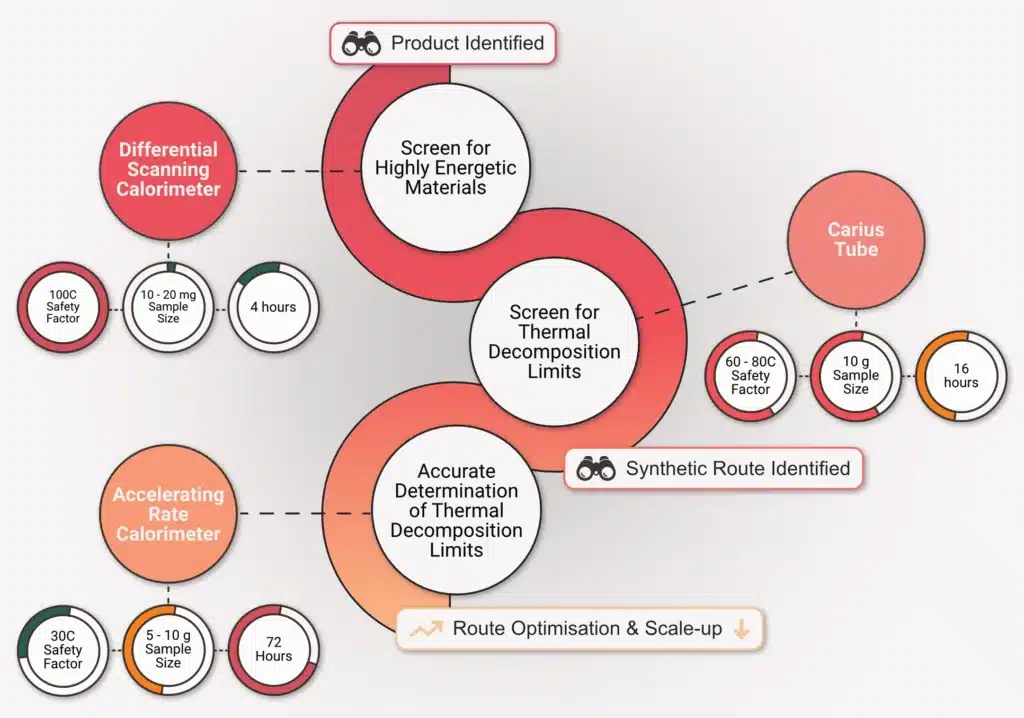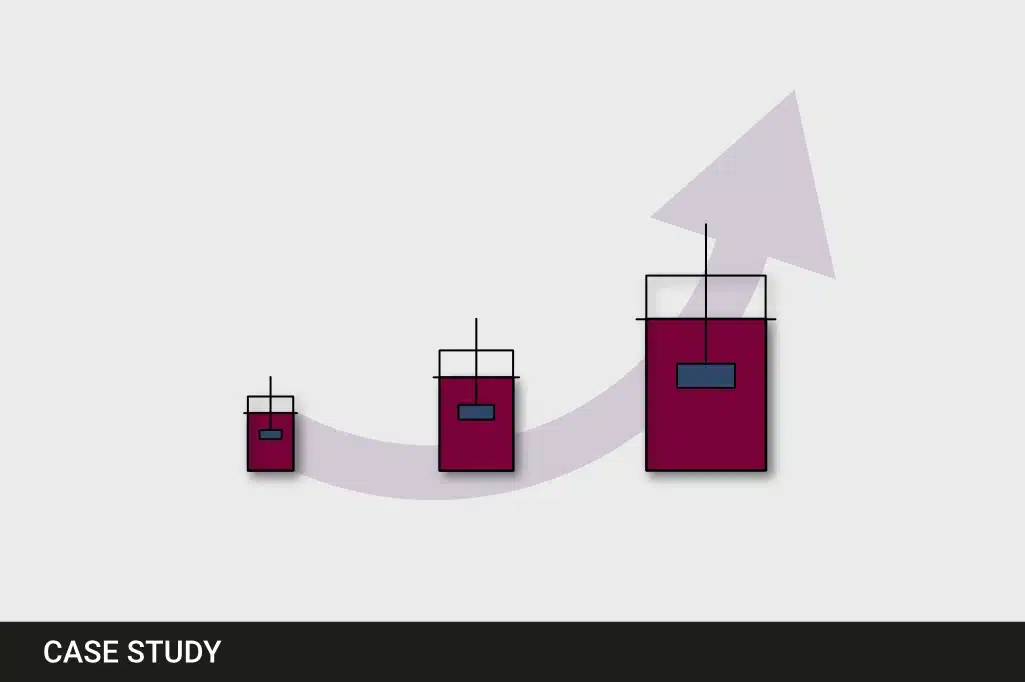During new process and product development, a primary chemical processing concern is the safe and efficient processing of materials and chemicals at large scale.
To counter these process safety concerns, thermal stability and adiabatic calorimetry testing methods act as valuable screening steps in the development of new chemical processes.
While these screening test methods do not provide the depth of data that advanced reaction calorimetry methods offer, they are an excellent first step to understanding the fundamental characteristics (reactivity behaviours) of a potentially hazardous material.
The preliminary data collected at the screening stage will guide research and development teams in their process development journey, especially during the product identification and the identification of synthetic route stages.
This thermal screening data can then be used to inform and ensure proper plant design (reactor cooling capacity, relief sizing, etc.) for scale-up stages.

*Potential Chemical Process Flow
In this article, we will provide details about various thermal stability and adiabatic calorimetry testing methodologies, and how they can integrate into your early chemical process development.
Benefits of Thermal Screening/Stability
- Low Sample Requirement: Minimal sample requirements are an ideal choice for early-stage process development when only limited quantities of a material are available.
- Speed of Results: Many thermal stability tests can be completed in just hours. The quick testing turnaround ensures that process chemists and engineers can assess a material’s reactivity, make informed decisions, and plan the next stage of the next stage of the process lifecycle accordingly.
- Indicative Data: While the data obtained from thermal screening tests may not be as accurate as more advanced adiabatic techniques, they do provide indicative information. Exothermic peaks and/or unusual behaviours observed can guide process teams as they transition to more comprehensive testing methods.
- Safety Considerations: By identifying potential thermal hazards early in the development process, necessary precautions and safety measures can be quickly recognised.
Benefits of Adiabatic Methods
The term ‘adiabatic’ in calorimetry signifies a specific condition where no heat is exchanged or lost to surroundings during a chemical reaction or decomposition.
Adiabatic calorimetry supports precise measurements for the heat effects associated with a chemical reaction and provides data on the reaction kinetics and energy generation/absorption. This implies that the heat generated or absorbed within the reaction system remains entirely within that system.
- Larger Sample Requirements: Adiabatic calorimetry tests are characterised by their increased sample requirements compared to thermal stability screening tests. This, in turn, will accurately simulate the conditions of a larger-scale reaction.
- Significant Accuracy: Adiabatic calorimetry offers greater accuracy due to a lower phi factor (a ratio of the relative mass and specific heat capacity of the sample to the test vessel). This will, however, come at the cost of longer testing run times. Although these tests will take up to several days to complete, the collected data will provide a more accurate understanding of the complex chemical reactions taking place.
- Experimentation: While achieving perfect adiabatic conditions may not always be possible, various methods to emulate this effect can be experimented with. By carefully controlling factors such as temperature, pressure, and insulation. The aim of this experimentation is to minimise heat exchange within a specific environment.
Thermal Stability/Screening Testing Methods
Differential Scanning Calorimetry (DSC)
- Use of small sample amount (5-10 mg)
- Suspected high energetic materials
- Best for homogenous or pure samples
- Onset and quantitative heat measurement
- No pressure data output
- Initial screening – may have lots of samples
The Differential Scanning Calorimetry (DSC) is flexible. This testing method typically starts with 5 to 10 milligrams of a material and is known for its rapid screening capabilities – it typically produces results in just a few hours.
One of the key advantages of the DSC is its ability to provide a breadth of data. Insights into phase transitions and critical temperature points like melting, boiling and glass transitions can be identified.
It’s essential to consider that the DSC does have certain limitations, primarily due to the small sample size it requires. With only 10 milligrams at disposal, it’s challenging to achieve the same level of accuracy particularly for heterogenous samples as methods employing more substantial samples.
How the DSC Works
The core principle behind the DSC is the differential temperature measurements.
By comparing the temperature profile of a material under investigation to that of a reference sample (one that exhibits no thermal events during the temperature ramp) to generate a heat flow measurement. The differences between the constant temperature profiles (sample/reference) provides the relevant data.
For a precise examination of thermal stability, high-pressure crucibles are then used. These crucibles ensure that no substances escape during the process of heating, resulting in the highest resolution of signals. This is significant for materials and chemicals that exhibit energetic decompositions, as even minor changes in mass can lead to loss of significant insights into the material’s behaviour under variable conditions.
Carius Tube
- Sample size of around 10 g
- All sample types: solids, liquids, heterogeneous mixtures
- Onset and non-adiabatic temperature rise (indication)
- Pressure/Gas data output
- Initial screening – may have lots of samples
Carius Tube testing is a technique tailored to provide data about materials and their energetic behaviours. While it may require a slightly larger sample (compared to the DSC), around 10 grams, it still retains its usefulness as a thermal screening method.
The duration of a normal Carius Tube Calorimetry test is approximately 12 hours, making it a method that strikes a balance between robust data collection and testing flexibility.
How the Carius Tube Works
The Carius Tube takes differential temperature measurements during throughout the testing lifecycle. Temperature variations between the oven temperature and the sample’s temperature are recorded and then plotted. These measurements provide data points that offer insights into the material’s behaviour over a temperature range and varying conditions.
The Carius Tube also can quantify and analyse any gases produced. Gas analysis helps ascertain the composition and nature of the gases generated. This feature is particularly advantageous when dealing with materials where gas composition may have a primary or secondary function.
Adiabatic Thermal Stability Testing Methods
Accelerating Rate Calorimetry (ARC)
- Sample size of 3-5 g available
- Accurate onset and adiabatic temperature rise
- Pressure/Gas data output
- Kinetic studies (TMR/SADT)
- Not a tool for screening lots of samples as test is slow
The Accelerating Rate Calorimeter (ARC) can work with relatively small sample sizes, typically ranging from 3 to 5 grams. As this test operates at higher temperatures, it becomes a practical choice for early/mid-stage process development and research.
The ARC is not a quick identification method as it typically takes about three days to complete a test. Analysts often turn to the ARC when they’ve identified potential hazards or areas of interest through the above thermal screening tests.
How the ARC works
One of the key components of the ARC is the use of a metallic bomb to contain heat in the sample. The choice of bomb type can vary depending on the specific requirements of the test. Within an ARC, there are different testing modes available to researchers: heat-wait-search mode, isothermal testing, and constant heat ramping.
The heat-wait-search (H-W-S) mode is often the preferred choice, as it provides precise data by incrementally stepping up the temperature at regular intervals, typically around five degrees every 30 minutes, then dwelling at that constant set temperature. This measured approach helps capture even subtle changes in temperature (0.02 °C/min) and the sample’s behaviour.
A feature of the ARC is its ability to match temperatures to maintain adiabatic conditions throughout its testing.
Adiabatic processes are those in which there is no exchange of heat with the experimental system and surroundings.
In the ARC, this is achieved by closely monitoring the sample’s temperature and making rapid adjustments to the oven temperature to match it. This precise temperature control ensures that no heat is lost from the sample to the vessel.
The ARC can detect any exothermic reaction within the sample, and as soon as an increase in temperature is detected, even by a fraction of a degree, the system responds by holding the temperature at that point. If the test detects an exothermic reaction heating event within the sample, it raises the oven temperature to match it, preserving the adiabatic conditions and preventing any heat loss.
Advanced Reactive Screening System Tool (ARSST)
- Low Phi data – T and P
- Energetic and gassy decompositions
- Data for relief vent sizing (screening)
- Pressure/Gas data output
- Kinetic studies (TMR/SADT)
- Open cell testing (good for gassy/tempered reactions)
- Heats of Mixing (Simple)
The Advanced Reactive Screening System Tool (ARSST) can also work with relatively small sample sizes, typically ranging from 5 to 8 grams. It is a very versatile testing system, again, making it a practical choice for early/mid-stage process development and research.
The ARSST is capable of modestly quick thermal stability test methods – it typically takes about a day to complete a test. The ARSST is normally used for gassy systems and when potential hazards or areas of interest have been identified through the above thermal screening tests.
How the ARSST works
The (ARSST) is a highly adaptable small scale batch reactor, used to measure the rate of temperature and pressure rise, to allow determinations of the energy and gas release rates during a runaway reaction, reaction calorimetry or fire simulation studies.
This unit consists of a well instrumented pressure vessel that typically holds a spherical glass test cell, where it can heat a 10 ml sample usually at a uniform rate up to 400 °C. The use of low weight glass vessels makes the ARSST a uniquely low phi-factor test, with values typically of around 1.05. The test sample and a magnetic stirrer are introduced into this cell as well as a thermocouple. The pressure inside the containment vessel is measured by a pressure transducer. Due to the unique heating method by a wraparound heater, the sample is kept in a pseudo‑adiabatic mode and a zero-heat loss to the environment condition is mimicked thanks to the low phi-factor.
Other bespoke testing methods can be used in the ARSST, such as isothermal testing, fire simulation scenarios, basic reaction calorimetry, tempered and boiling supressed systems and flow regime detection for relief sizing.
Integrate early-stage screening methodologies

Thermal screening and Adiabatic Calorimetry testing methodologies are an important step in understanding material reactivity during the early stages of a new chemical process and/or process development. These testing methods lay the foundation for informed decision-making in the research and development of chemical reaction hazards.
The integration of these testing methods alongside proper plant design will ensure that the prevention and control of hazards in your working environment will be adequately controlled.
Sigma-HSE can provide bespoke Thermal Screening and Adiabatic Calorimetry testing methodologies for your chemical processes.
To learn more about our Thermal Stability and Chemical Reaction Hazards testing suite, you can watch our on-demand webinar, here.



